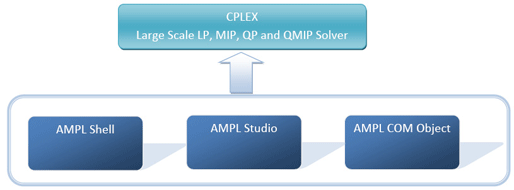OptiRisk Systems is the ONLY authorised reseller of IBM ILOG CPLEX in the UK and India.
AMPL’s solver interface supports linear, nonlinear, and mixed integer models with no built-in size limitations. This interface is rich enough to support many of the features used by advanced solvers to improve performance and solution accuracy, such as piecewise-linear constructs, representation of network problems, and automatic differentiation of nonlinear functions. To take advantage of these features, solvers must be written to utilize AMPL’s interface. OptiRisk provides support for the usage of AMPL with the CPLEX solver distributed by OptiRisk Systems

You choose a solver for a particular problem by giving its executable filename in the AMPL option solver command. For example, to use the (AMPL-compatible) CPLEX solver, type:
-> option solver cplex;
Most solvers have algorithmic options, such as CPLEX with its Mixed Integer and Barrier options. In these cases, you give the solver executable name to AMPL (for example, with option solver cplex); the solver will determine, from the problem characteristics as passed by AMPL (for example, a quadratic objective or integer variables) as well as solver options you specify, which algorithmic options will be used.
Key Features
Key Modelling environment features
Multiple solvers support: AMPL support multiple solvers including CPLEX and FortMP supplied by OptiRisk Systems.
AMPL can import both indexes and data directly from a database. After the model has been solved AMPL can also export the solution back to the database. Supported databases include Access, ODBC, Paradox, FoxPro, and Dbase for the Windows version and Oracle for the Motif version.
Direct Database Import and Export: Importing data from a variety of corporate database systems into optimization models is frequently an essential requirement for optimization projects. One of the advanced features of AMPL is the database connection option that directly links AMPL with relational databases and other data sources. This option enables the model developer to gather both indexes and data values from various data sources and import them directly into the model. After the model has been optimised, the solution output can be exported back into the database.
New looping and if-then-else commands can now be written to solve sequences of related problems, for sensitivity analysis and for decomposition or other iterative schemes.
Separation of model and data allows the AMPL models to be remain concise even as sets and data tables grow. Models may incorporate many kinds of conditions for validity of the data.
Extensive on-line help supports Windows context sensitive help for dialog boxes.
Interfaces to popular and sophisticated solvers including CONOPT, CPLEX, FortMP, MOPS, KNITRO, LGO, LANCELOT, LOQO, LSGRG, MINOS, OSL, SNOPT, and XA.
Modelling Features
Broad support for sets and set operators AMPL models can use sets of pairs, triples, and longer tuples; collections of sets indexed over sets; unordered, ordered, and circular sets of objects; and sets of numbers.
General and natural syntax for arithmetic, logical, and conditional expressions; familiar conventions for summations and other iterated operators.
Nonlinear programming features such as initial primal and dual values, user-defined functions, fast automatic differentiation, and automatic elimination of “defined” variables.
Convenient alternative notations including node and arc declarations for network problems, a special syntax for piecewise-linear functions, and column wise specification of linear coefficients.
Platforms
Supporting platforms
- MS Windows version: Windows 95, Windows NT, Windows 2000/XP
- Most variants of UNIX and Linux
This new release offers the highest performance of modelling languages on the market today.
Example of Use
To see the AMPL with CPLEX Example of Use please click here.
